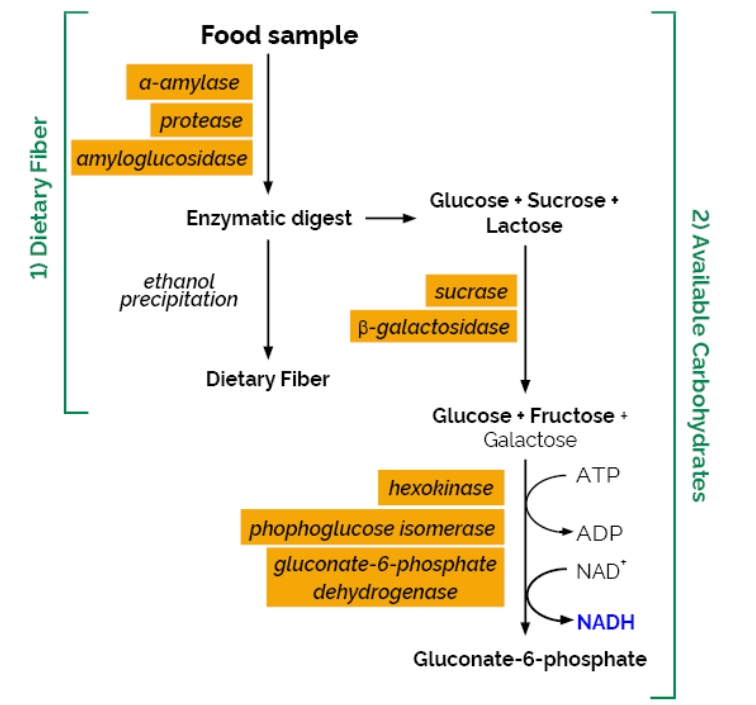- 背景資料
現行衛福部對膳食纖維的定義為:⌈人體小腸無法消化與吸收之三個以上單醣聚合之可食碳水化合物及木質素⌋
故膳食纖維涵蓋範圍廣泛,依據其不同的化學性質或分類方式,可大致分成以下幾類:
1️⃣抗性澱粉(Resistant Starch,簡稱RS),可分成5類,分別為RS1、RS2、RS3、RS4、RS5
2️⃣高分子量膳食纖維 (High Molecular Weight Dietary Fiber,簡稱HMWDF),此類別又可分成
➡️➡️非水溶性膳食纖維( Insoluble Dietary Fiber,簡稱 IDF)
➡️➡️高分子量水溶性膳食纖維(水溶但78%酒精不可溶)(Soluble Dietary Fiber which precipitates in 78% ethanol,High Molecular Weight Soluble Dietary Fiber,簡稱SDFP或HMWSDF)
3️⃣低分子量水溶性膳食纖維(水溶且78%酒精也可溶)( Soluble Dietary Fiber that remains soluble in 78% ethanol,non-digestible oligosaccharides,Low Molecular Weight Soluble Dietary Fiber,簡稱SDFS或NDO或LMWSDF)
⚠️備註⚠️
➡️低分子量水溶性膳食纖維需透過高效液相層析(HPLC)分析後,方可定量
➡️高分子量膳食纖維(HMWDF)=非水溶性膳食纖維(IDF) + 高分子量水溶性膳食纖維(SDFP)
➡️樣品中的總膳食纖維(Total dietary fiber ,簡稱TDF)=高分子量膳食纖維(HMWDF)+低分子量水溶性膳食纖維(LMWSDF)
➡️此套組測量膳食纖維之方法相似於AOAC Method 985.29 和 991.43,但不完全相同(例如:此方法 α-amylase加熱條件為 80°C + 35 min;AOAC Method 985.29方法α-amylase加熱條件為95°C + 30 min)
.jpg)
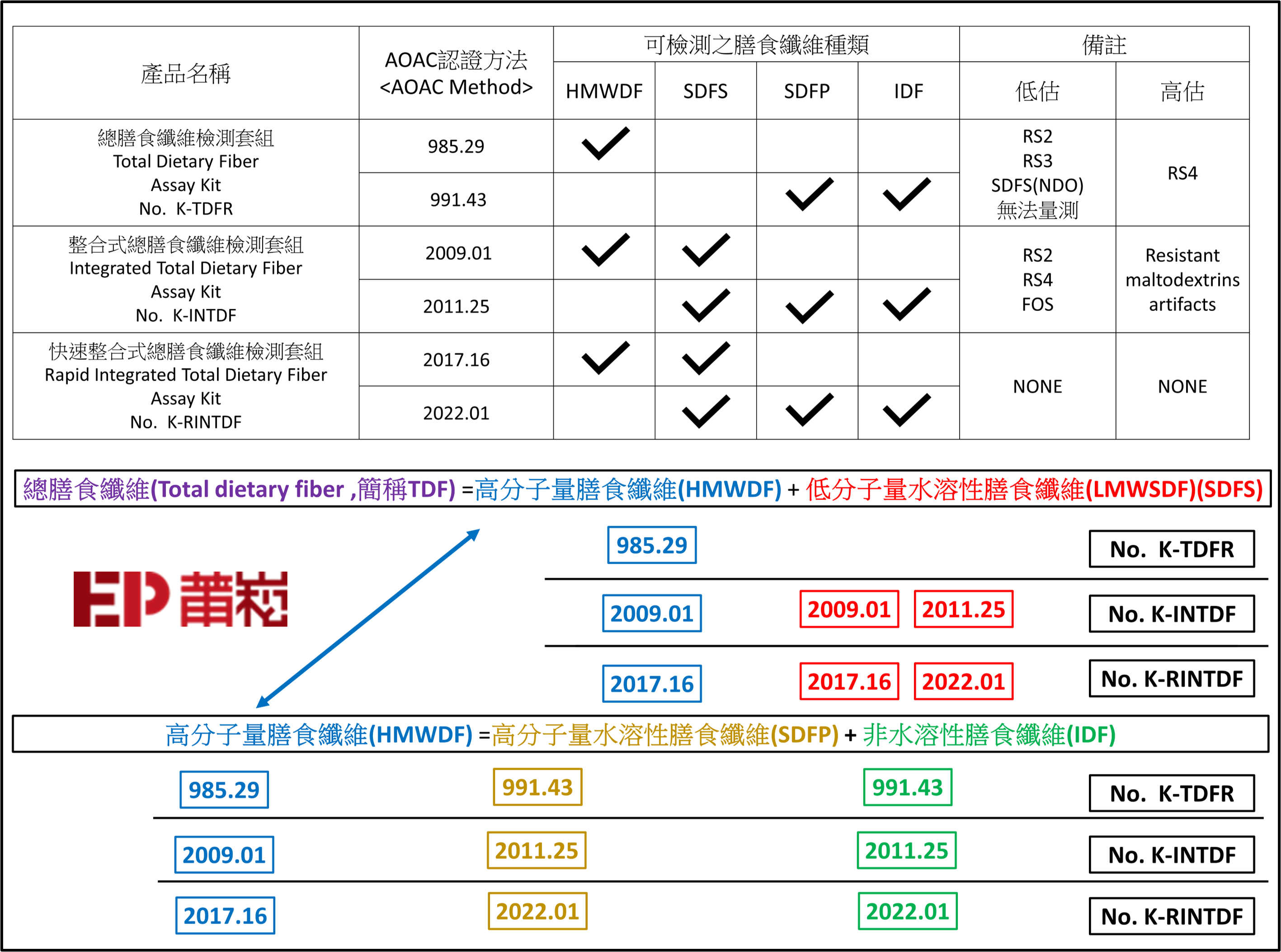
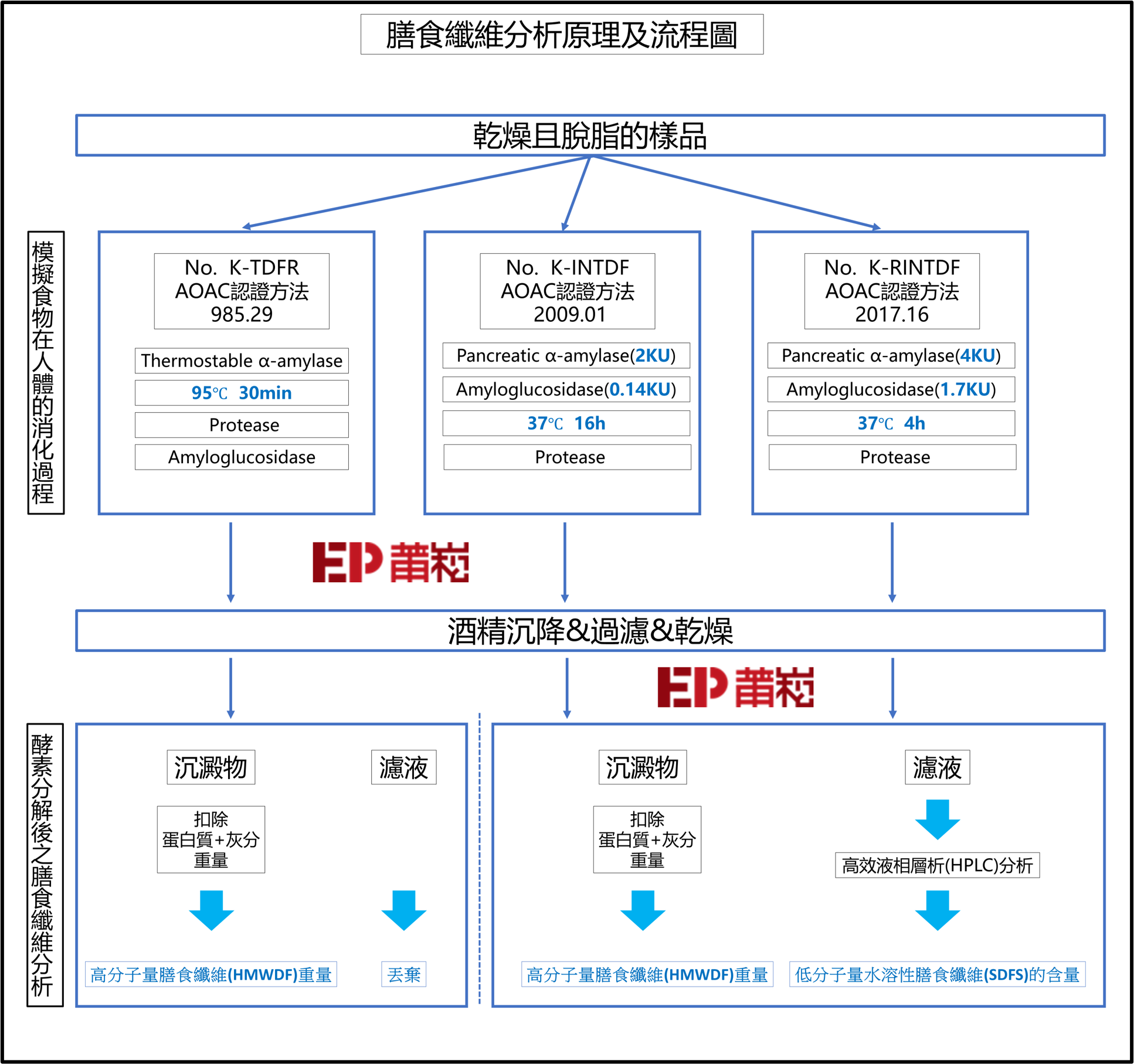
-
操作流程(膳食纖維)-PROCEDURE (DIETARY FIBER)
1. Blanks
With each assay, run two blanks along with samples to measure any contribution from reagents to residue.
2. Samples
a. Weigh duplicate 1.000 ± 0.005 g samples accurately into 250 mL Duran® bottles.
b. Add 40 mL MES-TRIS buffer solution (pH 8.0; Reagents not supplied, ‘7’, page 5) to each bottle. Add magnetic stirring bar to each bottle. Stir on magnetic stirrer until sample is completely dispersed in solution (this prevents lump formation, which would make sample inaccessible to enzymes).
3. Incubation with heat-stable α-amylase
a. Add 50 µL heat-stable α-amylase solution, while stirring at low speed.
b. Seal each bottle with plastic caps.
c. Place sealed bottles in shaking water bath at 80°C, and incubate for 35 min with continuous agitation. Start timing once all bottles are in hot water bath.
4. Cool
a. Remove all of the bottles from the water bath.
b. Adjust the temperature of water bath to 60°C by draining some of the hot water from water bath and adding cold water.
5. Incubation with protease
a. Allow the samples in the sealed bottles to cool to about 60°C and then add 100 µL of protease solution to each bottle one at a time (removing caps from the bottles one at a time and replacing these as soon as the enzyme has been added to minimise evaporative loss).
b. Incubate bottles in a shaking water bath at 60 ± 1°C, with continuous agitation for 30 min. Start timing when temperature of water bath reaches 60°C.
6. pH adjustment
a. Remove the sample bottles one at a time from the water bath.
b. Remove the cap from the first bottle and immediately add 5 mL of 3 M acetic acid solution into the bottle while stirring the solution on a magnetic stirrer (the pH will be 4.1-4.5).
No pH adjustment will be necessary.
7. Incubation with amyloglucosidase
a. Immediately add 200 µL of amyloglucosidase solution to the bottle with continuous stirring of the contents on a magnetic stirrer. Immediately cap the bottle.
b. Perform these same operations on each of the other bottles one at a time.
c. Incubate the bottles in a shaking water bath at 60°C for approx. 30 min, with constant agitation.
8. Removal of sample for ACH determination
a. Cool the contents of each bottle to approx 40°C by allowing them to stand at room temperature for approx. 10 min.
b. Shake the bottle contents to ensure that any liquid that has condensed on the neck of the bottle is mixed with the bulk solution.
c. Store the bottles at room temperature for a further 10 min to allow insoluble material to settle. Accurately remove a 1 mL sample from each bottle and transfer this to a 50 mL volumetric flask and adjust to volume with 100 mM sodium maleate buffer (pH 6.2; Reagents Not Supplied ‘8’, page 5) (overall dilution of 50-fold) and mix well.
d. If the solution is very turbid, filter an aliquot (approx. 10 mL) through a Whatman® No. 1 (9 cm) filter paper (in most cases, this step is unnecessary).
e. Analyse 0.2 mL of this solution immediately according to the procedure on page 13, or store below -10°C.
9. Precipitation of soluble dietary fiber
Add 160 mL of 95% (v/v) EtOH pre-heated to 60°C to each of the bottles detailed in point 8. Mix well on a magnetic stirrer and then remove the magnetic stirrer bar. Let the precipitate form at room temperature for 60 min.
10. Filtration setup
a. Tare crucible containing Celite to nearest 0.1 mg.
b. Wet and redistribute bed of Celite in crucible using approx. 3 mL of distilled water.
c. Apply suction to crucible to draw Celite onto fritted glass as an even mat.
11. Filter sample mixture from Step 9 through crucible into a filtration flask.
12. Wash the residue successively with three 15 mL aliquots of 78% (v/v) EtOH, two 15 mL aliquots of 95% (v/v) EtOH, and two 15 mL aliquots of acetone. In some cases, gums may form during filtration, trapping liquid in the residue. If so, break the surface film with a spatula to improve filtration. Long filtration times can be avoided by careful intermittent suction throughout filtration.
13. Dry the crucible containing the residue overnight at 70°C in a vacuum oven, or at 105°C in an air oven.
14. Cool the crucibles in a desiccator and weigh them to the nearest 0.1 mg. Subtract the crucible plus Celite weight to determine the weight of the residue.
15. Protein and ash determination
One residue from each type of fiber is analysed for protein, and the second residue of the duplicate is analysed for ash.
a. Perform protein analysis on residue using Kjeldahl method. Use N x 6.25 as the conversion factor for all samples to calculate g of protein. b. For ash analysis, incinerate the second residue for 5 h at 525°C. Cool in desiccator and weigh to nearest 0.1 mg. Subtract crucible and Celite weight to determine ash. (See Note 3, page 9).
- 操作流程-可獲得的碳水化合物含量-PROCEDURE (AVAILABLE CARBOHYDRATES)
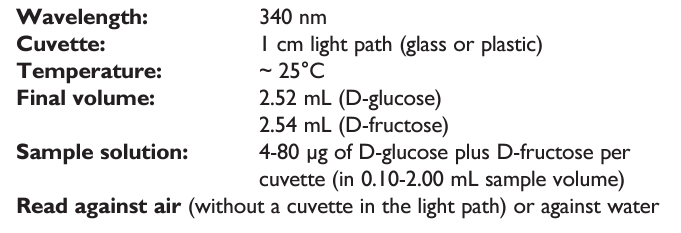
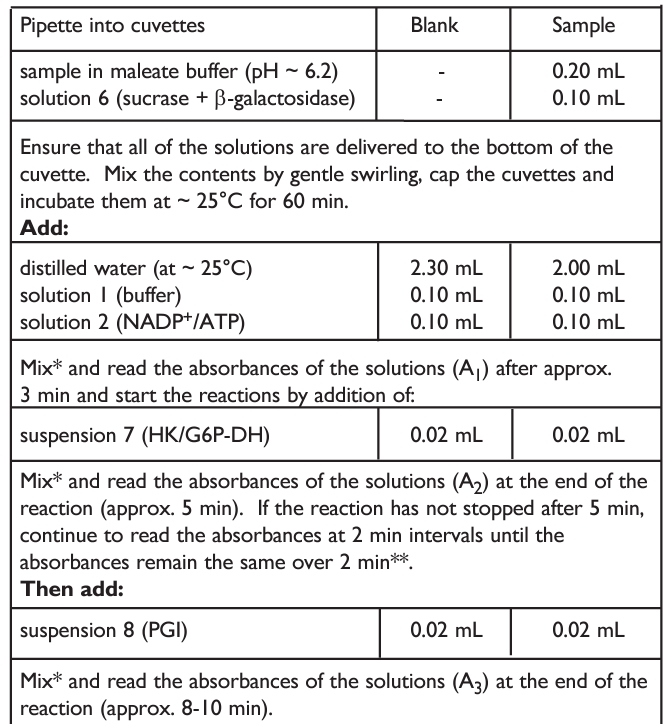

商品特色
商品規格
- 商品規格 (100個檢測反應)
Bottle 1:
Buffer (11 mL, pH 7.6) plus sodium azide (0.02% w/v) as a preservative.
Stable for > 3 years at 4°C.
Bottle 2:
NADP+ plus ATP.
Stable for > 5 years below -10°C.
Bottle 3:
Thermostable α-amylase (6 mL, 3,000 U/mL) (Megazyme cat. no. E-BLAAM).
Stable for > 3 years at 4°C.
Bottle 4:
Protease (10 mL, ~ 350 U/mL) (Megazyme cat. no. E-BSPRT).
Stable for > 3 years below -10°C.
Bottle 5:
Amyloglucosidase (20 mL, ~ 3,300 U/mL) (Megazyme cat. no. E-AMGDF).
Stable for > 3 years at 4°C.
Bottle 6:
Sucrase plus β-galactosidase, freeze-dried powder.
Stable for > 3 years below -10°C.
Bottle 7:
Hexokinase plus glucose-6-phosphate dehydrogenase suspension, 2.25 mL.
Stable for > 3 years at 4°C.
Bottle 8:
Phosphoglucose isomerase suspension (2.25 mL).
Stable for > 3 years at 4°C.
Bottle 9:
D-Glucose plus D-fructose standard solution (5 mL, 0.2 mg/mL of each sugar).
Stable for > 3 years at 4°C.
